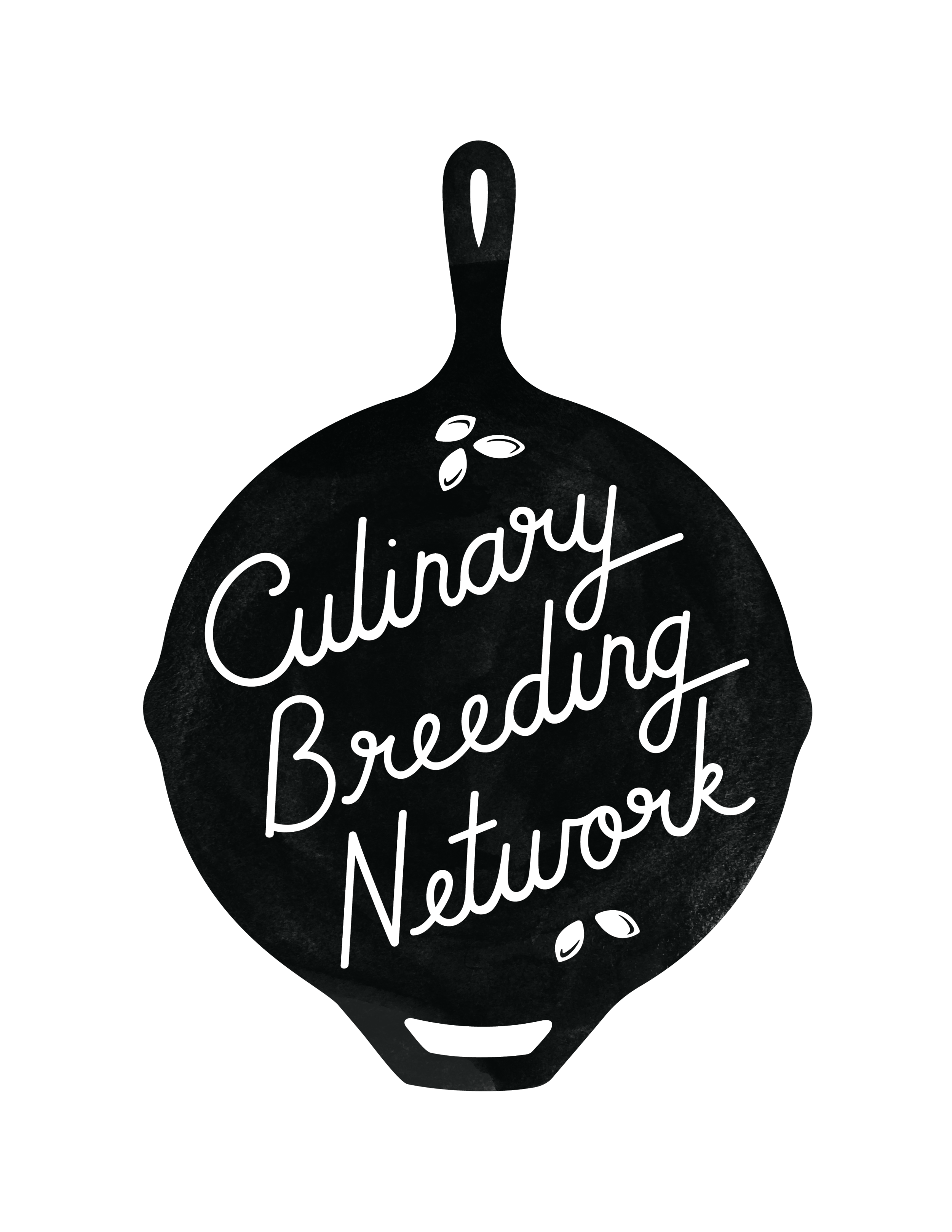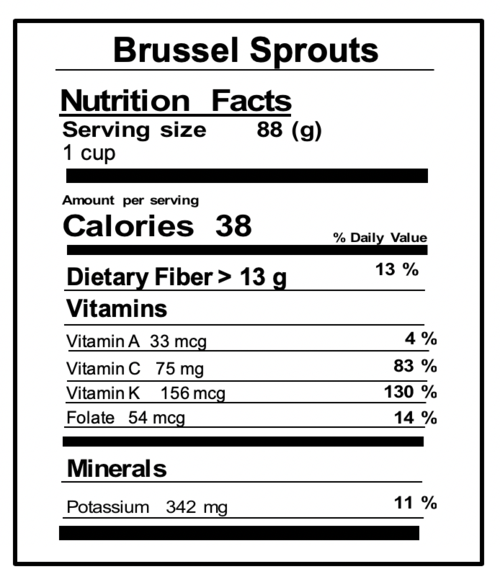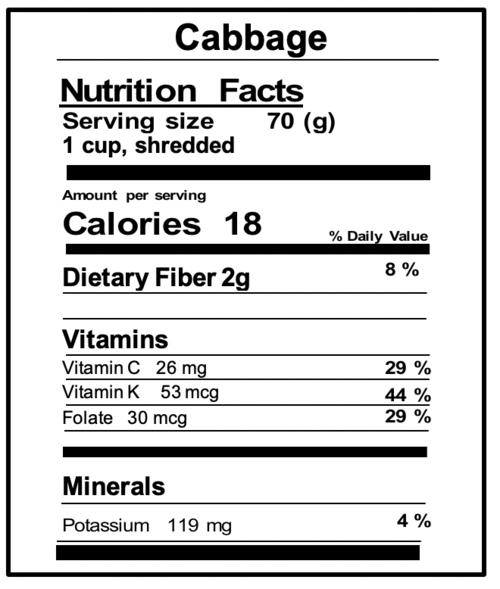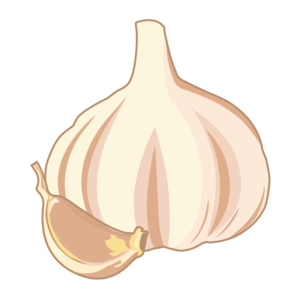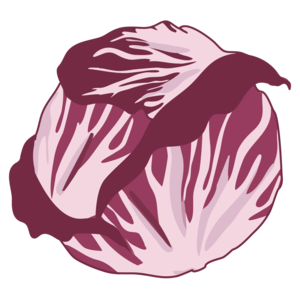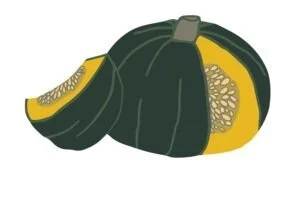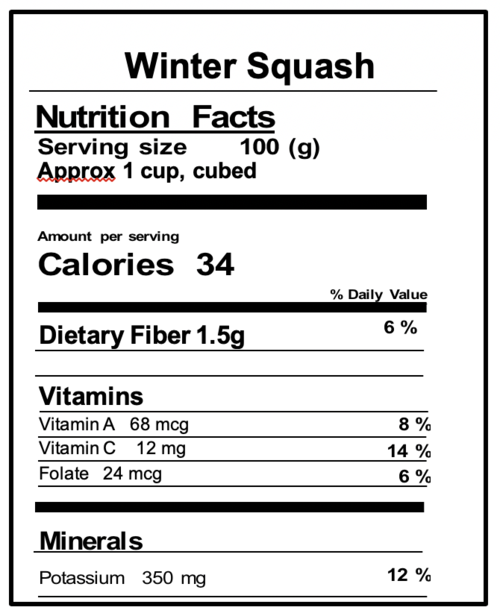Brussel Sprouts
Brussels sprouts, grown for their edible cabbage-like buds, are a juicy and sweet member of the Brassica oleracea family of cruciferous vegetables, which also includes broccoli, cauliflower, cabbage, kale, and collard greens. Cold weather enhances their natural sugar content, so their flavor peaks after the first frost of the year. They can be purchased in two forms: loose by the pound, or on the stalk. A stalk of Brussels sprouts can grow to a height of 3-feet and bear as many as 20-40 buds. This vegetable is named after the town in Belgium where it was cultivated in the 16th Century.
How to Select: Look for tightly-closed bright green leaves and firm buds. Smaller buds tend to taste sweeter, while larger buds take on a slightly bitter, cabbage-like flavor. Brussels sprouts purchased still on the stalk stay fresh longer.
How to Store: Store fresh loose Brussels sprouts unwashed in a plastic bag in the refrigerator crisper drawer. If purchased on the stalk, store them upright in fresh water. Brussels sprouts can last a week or a bit longer in the refrigerator, but they will start to lose their sweetness over time. As they age, the outer leaves may begin to wilt and turn yellow or brown. If this happens, simply remove outer leaves prior to cooking. To extend their life, Brussels sprouts can be blanched and then frozen to save for later use.
How to Prep: Remove any loose or yellowing leaves and trim off the base of the stem. Rinse in cold water. Brussels sprouts can be roasted, sautéed, steamed, baked into a gratin, or shaved with a sharp knife or mandolin for a raw salad. Be careful not to overcook as they can become mushy and give off an unappetizing sulfurous odor (don’t fret if this happens! The smell is due to a naturally occurring sulfur-containing phytochemical called glucosinolate found in cruciferous vegetables).
Nutritional Profile: Brussels sprouts have been shown in many research studies to reduce cancer risk due to decreased oxidative stress and inflammation as well as increased detox support, all of which can be linked back to the available nutrients of this tasty vegetable. (1) They contain high levels of glucosinolates, which are sulfur-containing compounds that are converted into another compound, isothiocyanates, when they are chopped, chewed, and digested. Isothiocyanates are used in regulating the body’s 2-step detox system. This is beneficial because the toxins that are held in the body between the two steps are actually more damaging.(2)(3) Brussels sprouts are also a good source of fiber, containing almost half of the recommended daily intake in 2 cups. Fiber is not only great for regulating the digestive system, it has also been shown to prevent cardiovascular disease and certain types of cancer. (4)
Cabbage
Cabbage is an oft-underrated member of the brassica family. Available as green, red (purple), or white (pale green) heads, this winter powerhouse vegetable is budget-friendly, nutritious, and incredibly versatile. Cabbage can be divided into two categories: 1. European (i.e. green, red, or savoy), and 2. Asian (i.e. napa and bok choy) varieties.
How to Select: Choose a compact head that feels dense and heavy for its size. Avoid cabbages with torn, withered, or yellowing outer leaves. Asian cabbage varieties are lighter and leafier. If purchasing cabbage at the farmers market, ask the farmer about the varieties offered and if there has been a frost. As with Brussels sprouts, cold weather enhances the natural sugar content.
How to Store: Store cabbage in the refrigerator crisper drawer, loosely wrapped in a plastic bag, to help retain moisture in the leaves. Avoid washing until ready to use. One medium head of cabbage can yield up to 14 cups of sliced or chopped cabbage, so wrap up any extra cabbage in a plastic bag and put it back in the refrigerator. Loose-leaved, crinkled varieties do not store as long as smooth, firm-headed types. Do not freeze cabbage.
How to Prep: Peel off any tough outer leaves and discard. To cut: 1. Quarter the cabbage. 2. Cut away a wedge of the core to release the leaves. 3. Cut the leaves to the size needed for in your recipe, or use a box grater or the shredder attachment on a food processor. For cabbage rolls or stuffed cabbage, simply peel off whole layers of leaves, being careful to keep them intact. Cabbage can be soaked in cold water to leech some of the bitter compounds, if a milder taste is desired. Similar to Brussels sprouts, overcooked cabbage can get mushy and take on an unpleasant smell.
Nutritional Profile: Cabbage is a great source of vitamins K and C, with some varieties containing more than half of the recommended daily intake for adults in a single cup! Vitamin K isn't very well known, but it is an important vitamin that supports blood clotting function (healing cuts) and bone health (preventing osteoporosis). Most of us are familiar with Vitamin C - it is an important nutrient that acts as an antioxidant and is associated with immune system support.(1)(2)(3) Cabbage also contains anti-inflammatory compounds like phenolics that reduce potentially cancer-causing oxidative stress in the body. Its high flavonoid content helps reduce chronic inflammation, thereby reducing the risk of cancers and other inflammation-related diseases. (4)(5)
Cauliflower
Cauliflower is another member of the species Brassica oleracea. Although white cauliflower is the most common, it is also available in an array of stunning colors, including orange, green, and purple. Again, like many winter vegetables, cold weather brings out its sweetness, so cauliflower purchased after the first frost of the year will be most flavorful.
How to Select: Look for firm heads with densely-packed florets with even coloring. Avoid heads that show dark blemishes, wet spots, or have a strong odor.
How to Store: Store cauliflower loosely wrapped in a plastic bag in the refrigerator crisper drawer. Cauliflower sold at a grocery is often tightly wrapped in plastic. This traps moisture and promotes rot, so remove the plastic wrapping prior to storing it in the refrigerator. Stored properly, cauliflower will keep for several weeks. Pale brown spots on the surface of cauliflower buds may appear over time, due to normal processes of oxidation. A head with some discoloration is still perfectly edible, as long as those spots aren’t dark or mushy, or give off a strong odor. If the cabbage is still edible, simply scrape away the brown spots with a knife.
How to Prep: Cauliflower buds can be cooked, boiled, pickled, or eaten raw. The inner stalk and leaves can also be used for culinary purposes, like making stocks for soup. To cut: 1. Remove the outer leaves and cut the head into quarters through the core. 2. Cut away the inner stem and the cauliflower florets will fall apart in large clusters. These florets can be cut into smaller pieces as desired using a knife or simply by snapping them apart with your hands. Rinse the florets in a colander to remove any grit or dirt. Some recipes may call for the whole head, in which case merely remove the outer leaves and cut away the fibrous stem.
Nutritional Profile: Cauliflower has a higher phenolic compound content than other cabbage family plants.(1) Phenolic compounds are powerful antioxidants on their own, but some also help stimulate the creation of new antioxidant molecules in the body(2), increasing total antioxidant levels. Antioxidants reduce inflammation, which has been shown to lead to health conditions like arthritis, glaucoma, and diabetes, so consuming high phenolic content foods can help prevent these diseases! Another nutrient in cauliflower is sulforaphane. Sulforaphane has been shown to have some major antioxidative and antiinflammatory effects on the body, and these have been linked to reduced rates of cancer.(3) Despite being delicious when cooked, cooking cauliflower destroys some of these awesome nutrients so be sure to enjoy raw from time to time! (4)
Celeriac
Celeriac, also known as celery root, is an edible stem botanically related to celery. It has a mild, earthy celery-like flavor with a starchy, potato-like texture.
How to Select: This is not a vegetable selected for its beauty. Often gnarled and hairy, its appearance may appear intimidating. The key is to select a root that is heavy for its size.
How to Store: Wrap unwashed celeriac in plastic wrap and store it in in the refrigerator crisper drawer where it will last for several weeks. Don’t wash or trim celeriac until you are ready to use it, as it will start to brown quickly.
How to Prep: Cut off the top and bottom of the celeriac so that it lays flat on a cutting board. Peel or trim away the outer skin to get to the flesh. If cutting into the celeriac ahead of time, immerse the pieces into a bowl of water with a squeeze of lemon juice or a splash of white wine vinegar to halt oxidation. Celeriac can be eaten raw or cooked. It can be shaved very thin in a crisply salad or roasted like a root vegetable, pureed in a silky soup, or mashed like potatoes.
Nutritional Profile: There isn't much information available on celeriac's nutritional benefits. However, it is a member of the antioxidant-rich carrot family, so we can assume it is also an antioxidant-rich food.(1) Antioxidants reduce oxidative stress, so eating an antioxidant rich diet reduces the risk of many chronic diseases. Celeriac has a low glycemic index, meaning it has little effect on blood sugar levels. For this reason, celeriac could be a good choice for diabetics looking to diversify their low glycemic food options. It has a potato-like consistency, so it could be used as a substitute for potatoes, which have a high glycemic index.(2) High blood sugar in non-diabetics can cause fatigue and increased hunger, so we should all think about incorporating celeriac into our diets!
Garlic
Garlic is a species in the genius, Allium. It is closely related to onions, shallots, leeks, and chives. There are many different varieties or subspecies of garlic, most notably hardneck and softneck. It is used worldwide as a culinary seasoning and a dietary supplement. Most of the garlic consumed in Oregon is sourced from outside the state, and most of that is sourced from outside the U.S ( Mexico and Argentina). However, Oregon’s mild wet winters and dry summers make it an excellent place to grow specialty garlic! Fresh market garlic growers can sell specialty garlic products year-round by selling garlic greens, bunched green garlic, garlic scapes, green garlic bulbs, and a time series of dried bulb varieties, starting with those with a short storage life and finishing with those with a very long storage life.
How to Select: Pick bulbs that are plump and compact with a tight layer of papery skin. Avoid bulbs that feel hollow, submit to light pressure, or have sprouts forming on the ends.
How to Store: Store whole heads of garlic at room temperature in a dry, dark place, with plenty of air circulation, for up to several months. Garlic’s lifespan decreases when the head is broken up for individual cloves. Avoid storing garlic in the fridge. Leftover peeled or chopped garlic can be sealed in an airtight container and stored in the refrigerator for a few days before it starts to lose flavor. If sprouts begin to form, simply remove them with a paring knife. Whole heads of garlic can be roasted and stored in the refrigerator for up to two weeks, or frozen for up to three months. Chopped garlic can also be preserved in oil and stored in the refrigerator for up to three weeks for adding to a variety of dishes, including pasta, soups, or salads.
How to Prep: Peel off the outer papery skins encasing the bulb and discard. Pull apart the cloves. Slice off the end of the clove where it was attached to the bulb. Smashing a clove with the flat edge of a knife makes it easier to remove and discard the skins. Chop or thinly slice the clove, or pass it through a garlic press and then add to an endless number of recipes.
Nutritional Profile: The health benefits of garlic are well researched. Garlic is known to aid in the prevention of heart related diseases and various types of cancer and positively influences the immune system. Garlic also possesses certain antibacterial properties.(1) The major bioactive nutrients found in garlic are called organosulfur compounds, the most active of which is called allicin. Allicin has antibacterial, anti-cancer, anti-inflammatory, pro-digestive and cardiovascular protective characteristics. Allicin is a compound that needs to be activated. To do this you simply need to chop or crush a clove of garlic before using it. (2)(3) Fun Fact: Garlic has been found in ancient Egyptian tombs, where it was likely an offering for entering the afterlife.(4)
Purple Sprouting Broccoli
Purple sprouting broccoli is an English heirloom in the brassica family that is bred for overwintering. It produces many small broccoli as opposed to standard broccoli’s single head. The best varieties have tender stems, sweet flavor, and buds that are about 2 inches across. Its beautiful purple color signals the presence of anthocyanins, a health promoting antioxidant. Purple sprouting broccoli is gaining popularity as a gourmet produce and can be used in place of traditional broccoli in an array of dishes. The harvest window (February-March) comes at a time when there is less diversity in locally-grown produce and when storage crops are waning, meaning it provides a fresh and local food source and provides farmers with a stream of income at the same time.
How to Select: Pick out bunches with dark colored and vibrant green-purple leaves and florets. Avoid plants with yellowy florets or wilted leaves.
How to Store: Purple sprouting broccoli can be kept unwashed in an open bag in the refrigerator for up to about two weeks, however, older buds may start to develop a strong, bitter flavor.
How to Prep: Trim away woody or fibrous ends and remove tough leaves with a knife. Divide into small, individual florets. You can slice thicker stems and cook them alongside florets. Rinse under cold water just before using to clean away and dirt or debris. The florets and stems can be steamed, sautéed, roasted, or served raw in recipes. Purple sprouting broccoli cooks quickly and retains its texture nicely. It will, however, lose its purple hue when put into contact with high heat.
Nutritional Profile: Broccoli is considered by some to be the “crown jewel of nutrition” due in part to its high antioxidant content. Purple sprouting broccoli, because of its lovely purple coloration, has higher levels of antioxidants than green broccoli - a true super-food! Oxidative and antioxidative molecules work in tandem to regulate various cellular functions in our bodies. When there are more oxidative molecules than antioxidative molecules, our bodies are put into a stressed state that can lead to chronic inflammation, which has been shown to lead to health conditions like arthritis, glaucoma, and diabetes.(1) Consuming antioxidant-rich foods like purple sprouting broccoli tips the balance towards the antioxidants. The major antioxidants found in purple sprouting broccoli are vitamin C, carotenoids and polyphenols. Some of the most abundant carotenoids in purple sprouting broccoli are lutein and zeaxanthin, both of which have been shown to help our eyes filter out detrimental blue light. Blue light comes from the sun and most of our technological devices, and has been shown to pass through to the back of the eye which can break down light receptors in the eye. So these antioxidants not only reduce inflammation, they also help prevent eye diseases.(2)(3)(4) Fun Fact: Broccoli seeds were originally brought from Italy to North America by President Thomas Jefferson in 1767 and planted in the vegetable garden at Monticello, his plantation near Charlottesville, Virgina.(5)
Radicchio
Radicchio is a member of the chicory family, a term used to refer to all vegetables in the Chicorium genus which also includes frisee, escarole, Belgian endive, and dandelion greens. At its most basic, Radicchio is the name used to refer to varieties of chicory that form a tight head. There are many varieties of this beautiful, nutritious, and versatile winter vegetable. Just as Romaine, Bibb, and Leaf lettuce are all “lettuce”, so too are Rosso di Treviso and Castelfranco types of radicchio. The Pacific Northwest has the perfect climate for growing this beloved bitter vegetable and radicchio, generally, thrives without heavy nutrient inputs, is fairly free from pest and disease issues, and holds well in the field and in cold storage.
Visit Chicory Week for information, events, and recipes celebrating a robust local radicchio culture.
How to Select: Pick fresh, compact, bright colored heads with prominent mid-ribs. Avoid radicchio with cracks, spots, or bruising on the leaves.
How to Store: Radicchio stores for weeks in the refrigerator crisper drawer, although the sooner it is eaten the better its flavor will likely be. Do not wash before storing in the fridge, wait until you are ready to serve it.
How to Prep: Remove any wilted or discolored outer leaves then run the whole head under cool water to remove any dirt or debris. Cut in half and remove the inner stem by cutting out a “V” shape. Then you can tear the leaves roughly for larger pieces, or shred it finely with a sharp knife, depending on how you are serving it. Radicchio can be eaten in many different preparations: raw in a salad, sautéed, braised, charred, baked on pizzas, cooked in risottos, and more! Quickly soaking radicchio in ice cold water will tame some of its bitterness, as will cooking it. Here is a handout with suggestions on taming radicchio’s bitterness with other ingredients.
Nutritional Profile: Known for its bitter flavor profile, radicchio is also a great source of important nutrients such as vitamin K and antioxidants. Vitamin K is used by the body for maintaining proper bone health and supporting blood’s ability to clot. One cup of shredded radicchio can contain 85-100 percent of an adult’s recommended daily intake of vitamin K.(1)(2) Some of the beneficial antioxidants that can be found in radicchio are carotenoids and phenolic compounds. Antioxidants linked to eye health, lutein and zeaxanthin can be found in considerable levels.(3) Phenolic compounds such as anthocyanins are also found in high levels in radicchio, the antioxidants that tend to be found in red or purple colored foods. These powerful antioxidants can have beneficial health effects including reduced risk of cardiovascular disease or type 2 diabetes.(4)(5)
Winter Squash
At first the number of varieties of winter squash might seem confusing! Thankfully, squash fall into four main cooking categories - sweet, simple, salad, and saucy. Different types of squash can be made into delicious main courses, salads, side dishes, and desserts. The Eat Winter Vegetable project focuses specifically on Tetsukabuto and Black Futsu squash. Tetsukabuto (Tetsu) is a cross between a Cucurbita moschata (butternut type) and a Cucurbita maxima (kabocha type) and it truly is a workhorse squash! It is extremely productive, resistant to diseases and insects, and it stores and stores and stores (you get the point) very well. Black Futsu is a small open pollinated squash from Japan becoming more popular. It has a fruity fine-grained flesh and edible skin that makes it great in a salad. Black Futsu turns from a dark green to tan as it ripens. Visit the Eat Winter Squash project site for a world of information on the winter squash varieties that grow and store well in Oregon (and taste great!)
How to select: Since winter squash come in such a wide range of shapes, colors, and sizes, it can be helpful to ask your farmer about how to select from the diverse varieties. A squash should feel heavy for its size, be rich in color, and should have no cracks, bruises or soft brown spots. Squash may have a pale spot where it rested on the ground, which is perfectly okay!
How to store: When properly cured, most varieties of winter squash will last through the winter. Ask your farmer if the squash they are selling has been cured for storage (most likely it has!). As mentioned above, the Tetsu squash is famous for its ability to store for an exceptionally long time on your kitchen counter. Squash stores best at cool temperatures in a dark place. This could be a cool and dark shelf, cabinet, or drawer in the kitchen, pantry, or closet.
How to prep: Many winter squash have shapes that make them a bit tricky to peel or cut. To cut, use a large chef’s knife (think 8-inches or larger) and trim the stem and root ends first to create a flat surface that you can lay on the cutting board to stabilize your squash. Cut vertically through the center of the squash first. Always keep your fingers safe and hold the squash steady so it doesn’t slide out from under the blade as you cut. You may also want to put a damp towel under your cutting board to stabilize it because a slippery cutting board can be dangerous when cutting a hard winter squash. Use a spoon to scrape out the seeds and the wet fibers (you can keep your seeds to wash and roast them for a tasty crispy snack!). A melon baller can serve as a great tool to use for this step. Some varieties like delicate and sweet dumpling have more delicate edible skins meaning they don’t need peeling, however most tougher skins are not pleasant to eat. Carving away the peel with a knife may be easier than trying to use a peeler on uneven squash surfaces. Softening the squash for a few minutes in the microwave helps make peeling easier. If a squash is proving just too hard peel, simply cut it in half, remove the seeds and proceed with cooking it. Then deal with peeling or scraping out the flesh after it is cool enough to handle.
Nutritional Profile: The vegetables that make up the diverse category of winter squash are some of the most nutritious vegetables available in our diets today. While the amount of specific nutrients will vary from one variety to another, any winter squash consumption is something that brings a steady flow of nutrients into the body. (1) They are high in vitamin A, alpha-linoleic acid, and fiber. Winter squash is also a low-glycemic index food, meaning it has little effect on blood glucose levels. (2)(3) The vitamin A activity of winter squash can mainly be attributed to its content of beta-carotene, a nutrient the body can convert into vitamin A. Beta-carotene is what causes the orange and gold colors of the squash flesh and from a health standpoint has been linked to decreased risks for certain types of cancer. (4)(5) Also, just once cup of cooked winter squash can contain almost 10% of the daily recommended amount of Omega-3 for an average adult.(6)
